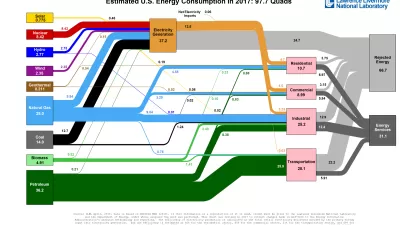Total on-site energy use in U.S. homes declined between 2009 and 2015, thanks to new new building technology and warmer winters.

Elizabeth La Jeunesse reports: "Although the number of U.S. households increased by about 4 percent between 2009 and 2015, total on-site energy usage in occupied U.S. homes declined by more than 10 percent, according to our analyses of survey results recently released by the U.S. Energy Information Administration (EIA)."
"Overall, while total households increased from 113.6 million in 2009 to 118.2 million in 2015, total site energy use by those households dropped by more than a quadrillion Btu, even as consumption increased among non-residential uses. As a result, the residential sector’s share of total U.S. energy consumption dropped from 22.4 percent in 2009 to 21.1 percent in 2015," adds La Jeunesse.
The article digs further into the data from the EIA, finding larger energy reductions in the multi-family housing sector, and breaking down reductions by the age of the building stock. The article also includes information about why and how energy use declined.
FULL STORY: U.S. HOUSEHOLDS ARE USING LESS ENERGY

Maui's Vacation Rental Debate Turns Ugly
Verbal attacks, misinformation campaigns and fistfights plague a high-stakes debate to convert thousands of vacation rentals into long-term housing.

Planetizen Federal Action Tracker
A weekly monitor of how Trump’s orders and actions are impacting planners and planning in America.

San Francisco Suspends Traffic Calming Amidst Record Deaths
Citing “a challenging fiscal landscape,” the city will cease the program on the heels of 42 traffic deaths, including 24 pedestrians.

Defunct Pittsburgh Power Plant to Become Residential Tower
A decommissioned steam heat plant will be redeveloped into almost 100 affordable housing units.

Trump Prompts Restructuring of Transportation Research Board in “Unprecedented Overreach”
The TRB has eliminated more than half of its committees including those focused on climate, equity, and cities.

Amtrak Rolls Out New Orleans to Alabama “Mardi Gras” Train
The new service will operate morning and evening departures between Mobile and New Orleans.
Urban Design for Planners 1: Software Tools
This six-course series explores essential urban design concepts using open source software and equips planners with the tools they need to participate fully in the urban design process.
Planning for Universal Design
Learn the tools for implementing Universal Design in planning regulations.
Heyer Gruel & Associates PA
JM Goldson LLC
Custer County Colorado
City of Camden Redevelopment Agency
City of Astoria
Transportation Research & Education Center (TREC) at Portland State University
Jefferson Parish Government
Camden Redevelopment Agency
City of Claremont





























